Policy Development: Public Health, Social Factors, and Obesity
VerifiedAdded on 2023/06/13
|6
|2064
|56
Essay
AI Summary
This essay delves into the intricacies of policy development within the context of public health, emphasizing the importance of the policy cycle as a framework for addressing health-related issues. It contrasts old and new public health approaches, highlighting the shift towards considering social, economic, and environmental determinants of health rather than solely focusing on biological factors. The essay also examines the influence of sociological factors such as gender, poverty, social class, race, and ethnicity on health outcomes, noting how inequalities in these areas contribute to disparities in health status. Furthermore, it addresses the growing concern of obesity in developed countries, advocating for social marketing campaigns, community-based interventions, and policy changes to promote healthy lifestyles. Finally, the essay considers the key factors in creating a smoke-free environment within a university setting, emphasizing the importance of management support, addressing student reactions, and allowing sufficient time for policy implementation. Desklib provides a platform to access more solved assignments and study resources for students.
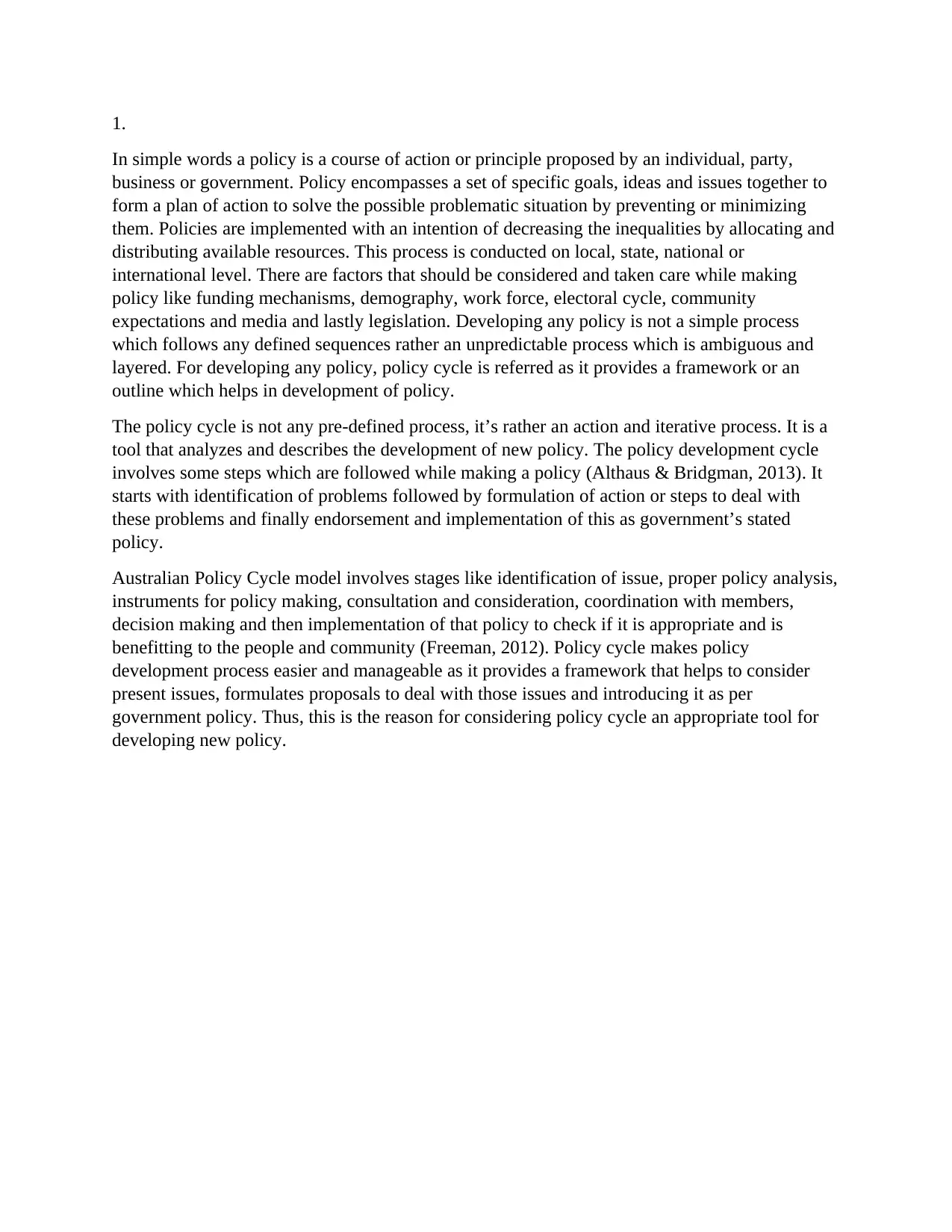
1.
In simple words a policy is a course of action or principle proposed by an individual, party,
business or government. Policy encompasses a set of specific goals, ideas and issues together to
form a plan of action to solve the possible problematic situation by preventing or minimizing
them. Policies are implemented with an intention of decreasing the inequalities by allocating and
distributing available resources. This process is conducted on local, state, national or
international level. There are factors that should be considered and taken care while making
policy like funding mechanisms, demography, work force, electoral cycle, community
expectations and media and lastly legislation. Developing any policy is not a simple process
which follows any defined sequences rather an unpredictable process which is ambiguous and
layered. For developing any policy, policy cycle is referred as it provides a framework or an
outline which helps in development of policy.
The policy cycle is not any pre-defined process, it’s rather an action and iterative process. It is a
tool that analyzes and describes the development of new policy. The policy development cycle
involves some steps which are followed while making a policy (Althaus & Bridgman, 2013). It
starts with identification of problems followed by formulation of action or steps to deal with
these problems and finally endorsement and implementation of this as government’s stated
policy.
Australian Policy Cycle model involves stages like identification of issue, proper policy analysis,
instruments for policy making, consultation and consideration, coordination with members,
decision making and then implementation of that policy to check if it is appropriate and is
benefitting to the people and community (Freeman, 2012). Policy cycle makes policy
development process easier and manageable as it provides a framework that helps to consider
present issues, formulates proposals to deal with those issues and introducing it as per
government policy. Thus, this is the reason for considering policy cycle an appropriate tool for
developing new policy.
In simple words a policy is a course of action or principle proposed by an individual, party,
business or government. Policy encompasses a set of specific goals, ideas and issues together to
form a plan of action to solve the possible problematic situation by preventing or minimizing
them. Policies are implemented with an intention of decreasing the inequalities by allocating and
distributing available resources. This process is conducted on local, state, national or
international level. There are factors that should be considered and taken care while making
policy like funding mechanisms, demography, work force, electoral cycle, community
expectations and media and lastly legislation. Developing any policy is not a simple process
which follows any defined sequences rather an unpredictable process which is ambiguous and
layered. For developing any policy, policy cycle is referred as it provides a framework or an
outline which helps in development of policy.
The policy cycle is not any pre-defined process, it’s rather an action and iterative process. It is a
tool that analyzes and describes the development of new policy. The policy development cycle
involves some steps which are followed while making a policy (Althaus & Bridgman, 2013). It
starts with identification of problems followed by formulation of action or steps to deal with
these problems and finally endorsement and implementation of this as government’s stated
policy.
Australian Policy Cycle model involves stages like identification of issue, proper policy analysis,
instruments for policy making, consultation and consideration, coordination with members,
decision making and then implementation of that policy to check if it is appropriate and is
benefitting to the people and community (Freeman, 2012). Policy cycle makes policy
development process easier and manageable as it provides a framework that helps to consider
present issues, formulates proposals to deal with those issues and introducing it as per
government policy. Thus, this is the reason for considering policy cycle an appropriate tool for
developing new policy.
Paraphrase This Document
Need a fresh take? Get an instant paraphrase of this document with our AI Paraphraser
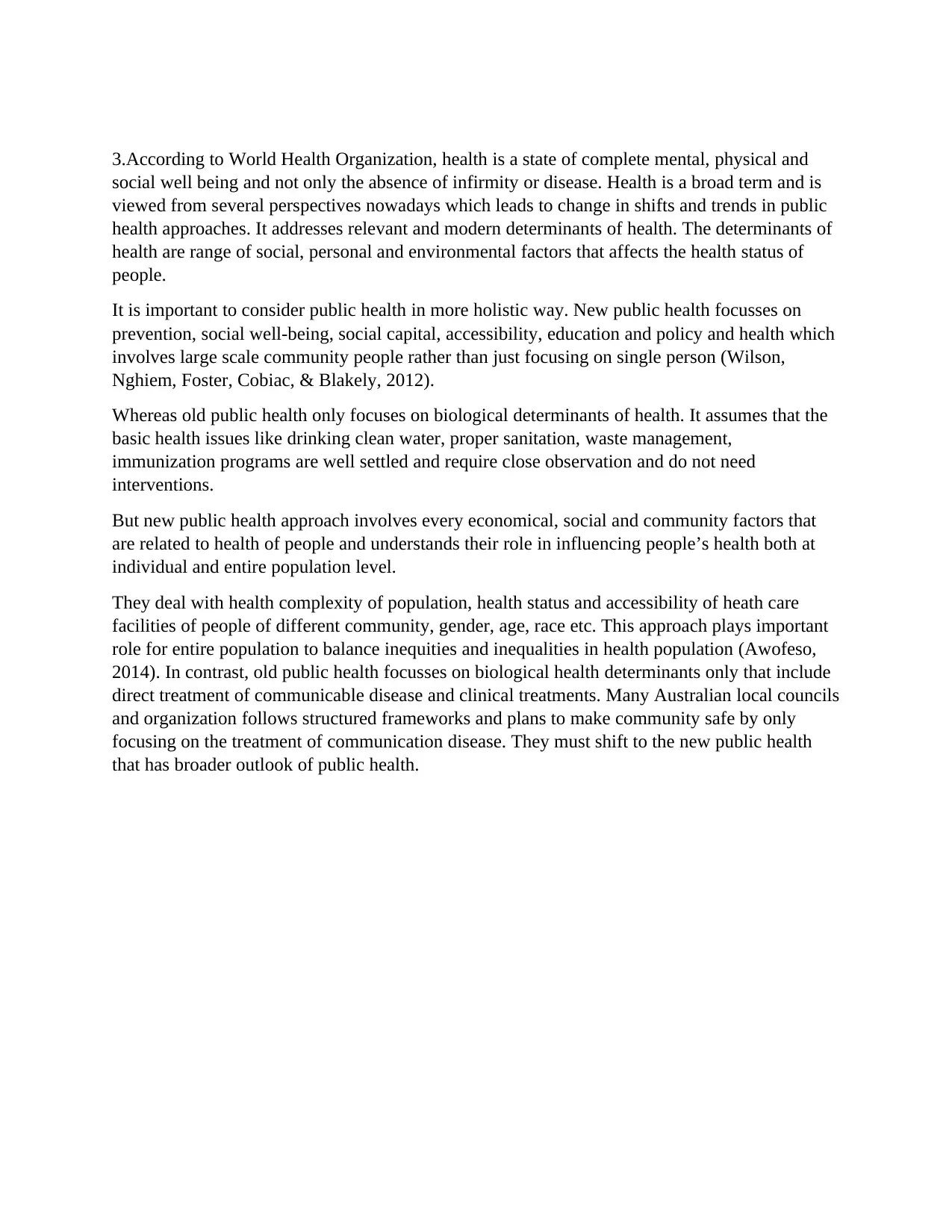
3.According to World Health Organization, health is a state of complete mental, physical and
social well being and not only the absence of infirmity or disease. Health is a broad term and is
viewed from several perspectives nowadays which leads to change in shifts and trends in public
health approaches. It addresses relevant and modern determinants of health. The determinants of
health are range of social, personal and environmental factors that affects the health status of
people.
It is important to consider public health in more holistic way. New public health focusses on
prevention, social well-being, social capital, accessibility, education and policy and health which
involves large scale community people rather than just focusing on single person (Wilson,
Nghiem, Foster, Cobiac, & Blakely, 2012).
Whereas old public health only focuses on biological determinants of health. It assumes that the
basic health issues like drinking clean water, proper sanitation, waste management,
immunization programs are well settled and require close observation and do not need
interventions.
But new public health approach involves every economical, social and community factors that
are related to health of people and understands their role in influencing people’s health both at
individual and entire population level.
They deal with health complexity of population, health status and accessibility of heath care
facilities of people of different community, gender, age, race etc. This approach plays important
role for entire population to balance inequities and inequalities in health population (Awofeso,
2014). In contrast, old public health focusses on biological health determinants only that include
direct treatment of communicable disease and clinical treatments. Many Australian local councils
and organization follows structured frameworks and plans to make community safe by only
focusing on the treatment of communication disease. They must shift to the new public health
that has broader outlook of public health.
social well being and not only the absence of infirmity or disease. Health is a broad term and is
viewed from several perspectives nowadays which leads to change in shifts and trends in public
health approaches. It addresses relevant and modern determinants of health. The determinants of
health are range of social, personal and environmental factors that affects the health status of
people.
It is important to consider public health in more holistic way. New public health focusses on
prevention, social well-being, social capital, accessibility, education and policy and health which
involves large scale community people rather than just focusing on single person (Wilson,
Nghiem, Foster, Cobiac, & Blakely, 2012).
Whereas old public health only focuses on biological determinants of health. It assumes that the
basic health issues like drinking clean water, proper sanitation, waste management,
immunization programs are well settled and require close observation and do not need
interventions.
But new public health approach involves every economical, social and community factors that
are related to health of people and understands their role in influencing people’s health both at
individual and entire population level.
They deal with health complexity of population, health status and accessibility of heath care
facilities of people of different community, gender, age, race etc. This approach plays important
role for entire population to balance inequities and inequalities in health population (Awofeso,
2014). In contrast, old public health focusses on biological health determinants only that include
direct treatment of communicable disease and clinical treatments. Many Australian local councils
and organization follows structured frameworks and plans to make community safe by only
focusing on the treatment of communication disease. They must shift to the new public health
that has broader outlook of public health.
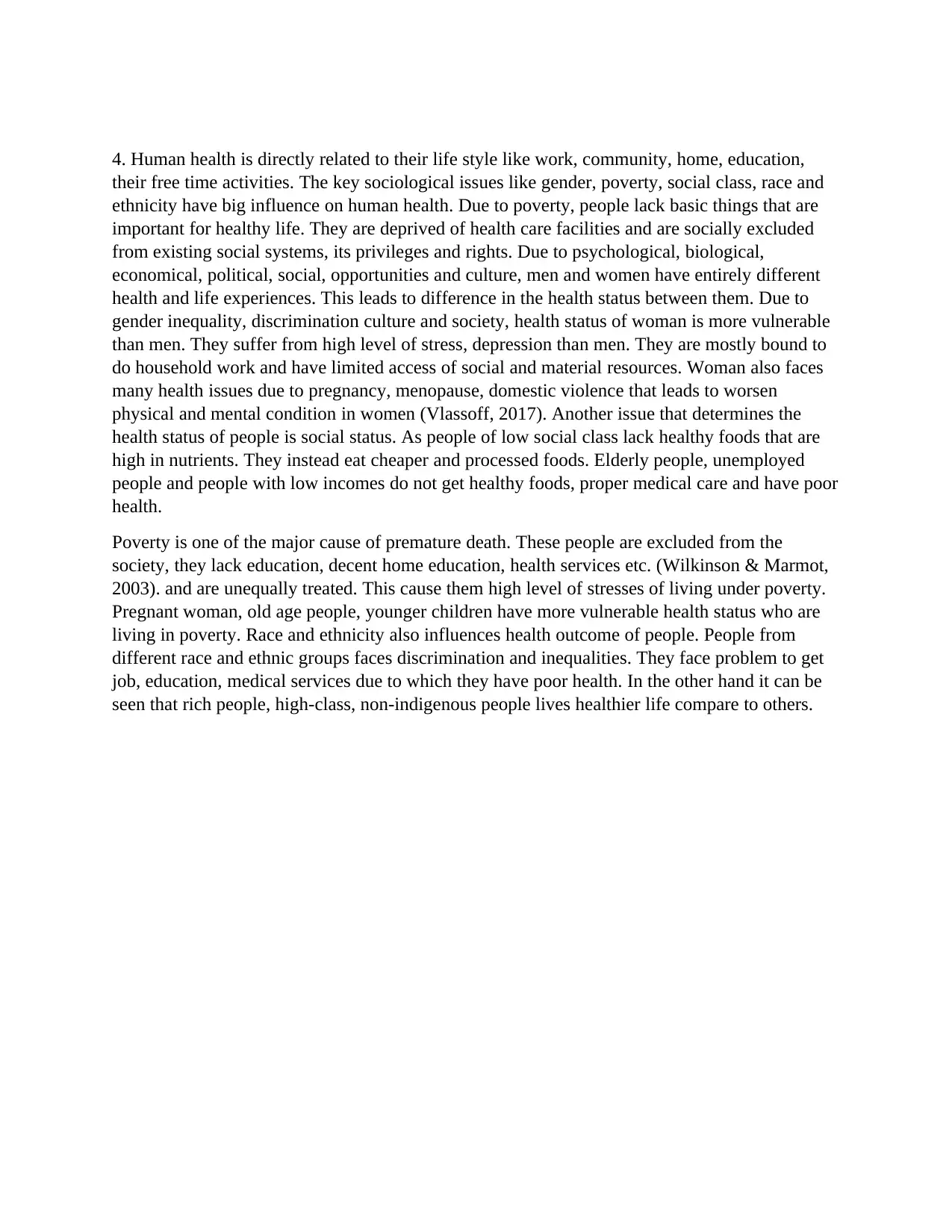
4. Human health is directly related to their life style like work, community, home, education,
their free time activities. The key sociological issues like gender, poverty, social class, race and
ethnicity have big influence on human health. Due to poverty, people lack basic things that are
important for healthy life. They are deprived of health care facilities and are socially excluded
from existing social systems, its privileges and rights. Due to psychological, biological,
economical, political, social, opportunities and culture, men and women have entirely different
health and life experiences. This leads to difference in the health status between them. Due to
gender inequality, discrimination culture and society, health status of woman is more vulnerable
than men. They suffer from high level of stress, depression than men. They are mostly bound to
do household work and have limited access of social and material resources. Woman also faces
many health issues due to pregnancy, menopause, domestic violence that leads to worsen
physical and mental condition in women (Vlassoff, 2017). Another issue that determines the
health status of people is social status. As people of low social class lack healthy foods that are
high in nutrients. They instead eat cheaper and processed foods. Elderly people, unemployed
people and people with low incomes do not get healthy foods, proper medical care and have poor
health.
Poverty is one of the major cause of premature death. These people are excluded from the
society, they lack education, decent home education, health services etc. (Wilkinson & Marmot,
2003). and are unequally treated. This cause them high level of stresses of living under poverty.
Pregnant woman, old age people, younger children have more vulnerable health status who are
living in poverty. Race and ethnicity also influences health outcome of people. People from
different race and ethnic groups faces discrimination and inequalities. They face problem to get
job, education, medical services due to which they have poor health. In the other hand it can be
seen that rich people, high-class, non-indigenous people lives healthier life compare to others.
their free time activities. The key sociological issues like gender, poverty, social class, race and
ethnicity have big influence on human health. Due to poverty, people lack basic things that are
important for healthy life. They are deprived of health care facilities and are socially excluded
from existing social systems, its privileges and rights. Due to psychological, biological,
economical, political, social, opportunities and culture, men and women have entirely different
health and life experiences. This leads to difference in the health status between them. Due to
gender inequality, discrimination culture and society, health status of woman is more vulnerable
than men. They suffer from high level of stress, depression than men. They are mostly bound to
do household work and have limited access of social and material resources. Woman also faces
many health issues due to pregnancy, menopause, domestic violence that leads to worsen
physical and mental condition in women (Vlassoff, 2017). Another issue that determines the
health status of people is social status. As people of low social class lack healthy foods that are
high in nutrients. They instead eat cheaper and processed foods. Elderly people, unemployed
people and people with low incomes do not get healthy foods, proper medical care and have poor
health.
Poverty is one of the major cause of premature death. These people are excluded from the
society, they lack education, decent home education, health services etc. (Wilkinson & Marmot,
2003). and are unequally treated. This cause them high level of stresses of living under poverty.
Pregnant woman, old age people, younger children have more vulnerable health status who are
living in poverty. Race and ethnicity also influences health outcome of people. People from
different race and ethnic groups faces discrimination and inequalities. They face problem to get
job, education, medical services due to which they have poor health. In the other hand it can be
seen that rich people, high-class, non-indigenous people lives healthier life compare to others.
⊘ This is a preview!⊘
Do you want full access?
Subscribe today to unlock all pages.

Trusted by 1+ million students worldwide
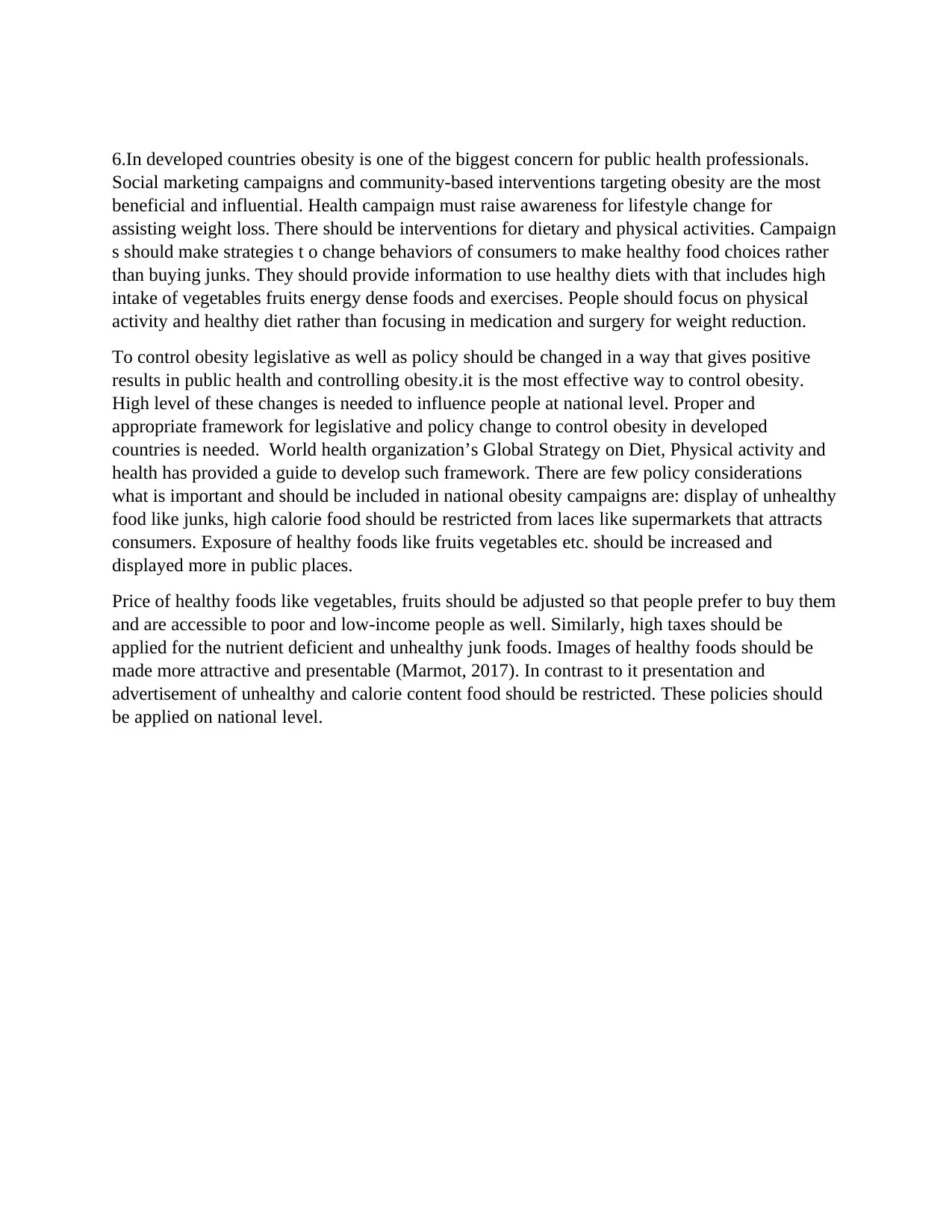
6.In developed countries obesity is one of the biggest concern for public health professionals.
Social marketing campaigns and community-based interventions targeting obesity are the most
beneficial and influential. Health campaign must raise awareness for lifestyle change for
assisting weight loss. There should be interventions for dietary and physical activities. Campaign
s should make strategies t o change behaviors of consumers to make healthy food choices rather
than buying junks. They should provide information to use healthy diets with that includes high
intake of vegetables fruits energy dense foods and exercises. People should focus on physical
activity and healthy diet rather than focusing in medication and surgery for weight reduction.
To control obesity legislative as well as policy should be changed in a way that gives positive
results in public health and controlling obesity.it is the most effective way to control obesity.
High level of these changes is needed to influence people at national level. Proper and
appropriate framework for legislative and policy change to control obesity in developed
countries is needed. World health organization’s Global Strategy on Diet, Physical activity and
health has provided a guide to develop such framework. There are few policy considerations
what is important and should be included in national obesity campaigns are: display of unhealthy
food like junks, high calorie food should be restricted from laces like supermarkets that attracts
consumers. Exposure of healthy foods like fruits vegetables etc. should be increased and
displayed more in public places.
Price of healthy foods like vegetables, fruits should be adjusted so that people prefer to buy them
and are accessible to poor and low-income people as well. Similarly, high taxes should be
applied for the nutrient deficient and unhealthy junk foods. Images of healthy foods should be
made more attractive and presentable (Marmot, 2017). In contrast to it presentation and
advertisement of unhealthy and calorie content food should be restricted. These policies should
be applied on national level.
Social marketing campaigns and community-based interventions targeting obesity are the most
beneficial and influential. Health campaign must raise awareness for lifestyle change for
assisting weight loss. There should be interventions for dietary and physical activities. Campaign
s should make strategies t o change behaviors of consumers to make healthy food choices rather
than buying junks. They should provide information to use healthy diets with that includes high
intake of vegetables fruits energy dense foods and exercises. People should focus on physical
activity and healthy diet rather than focusing in medication and surgery for weight reduction.
To control obesity legislative as well as policy should be changed in a way that gives positive
results in public health and controlling obesity.it is the most effective way to control obesity.
High level of these changes is needed to influence people at national level. Proper and
appropriate framework for legislative and policy change to control obesity in developed
countries is needed. World health organization’s Global Strategy on Diet, Physical activity and
health has provided a guide to develop such framework. There are few policy considerations
what is important and should be included in national obesity campaigns are: display of unhealthy
food like junks, high calorie food should be restricted from laces like supermarkets that attracts
consumers. Exposure of healthy foods like fruits vegetables etc. should be increased and
displayed more in public places.
Price of healthy foods like vegetables, fruits should be adjusted so that people prefer to buy them
and are accessible to poor and low-income people as well. Similarly, high taxes should be
applied for the nutrient deficient and unhealthy junk foods. Images of healthy foods should be
made more attractive and presentable (Marmot, 2017). In contrast to it presentation and
advertisement of unhealthy and calorie content food should be restricted. These policies should
be applied on national level.
Paraphrase This Document
Need a fresh take? Get an instant paraphrase of this document with our AI Paraphraser
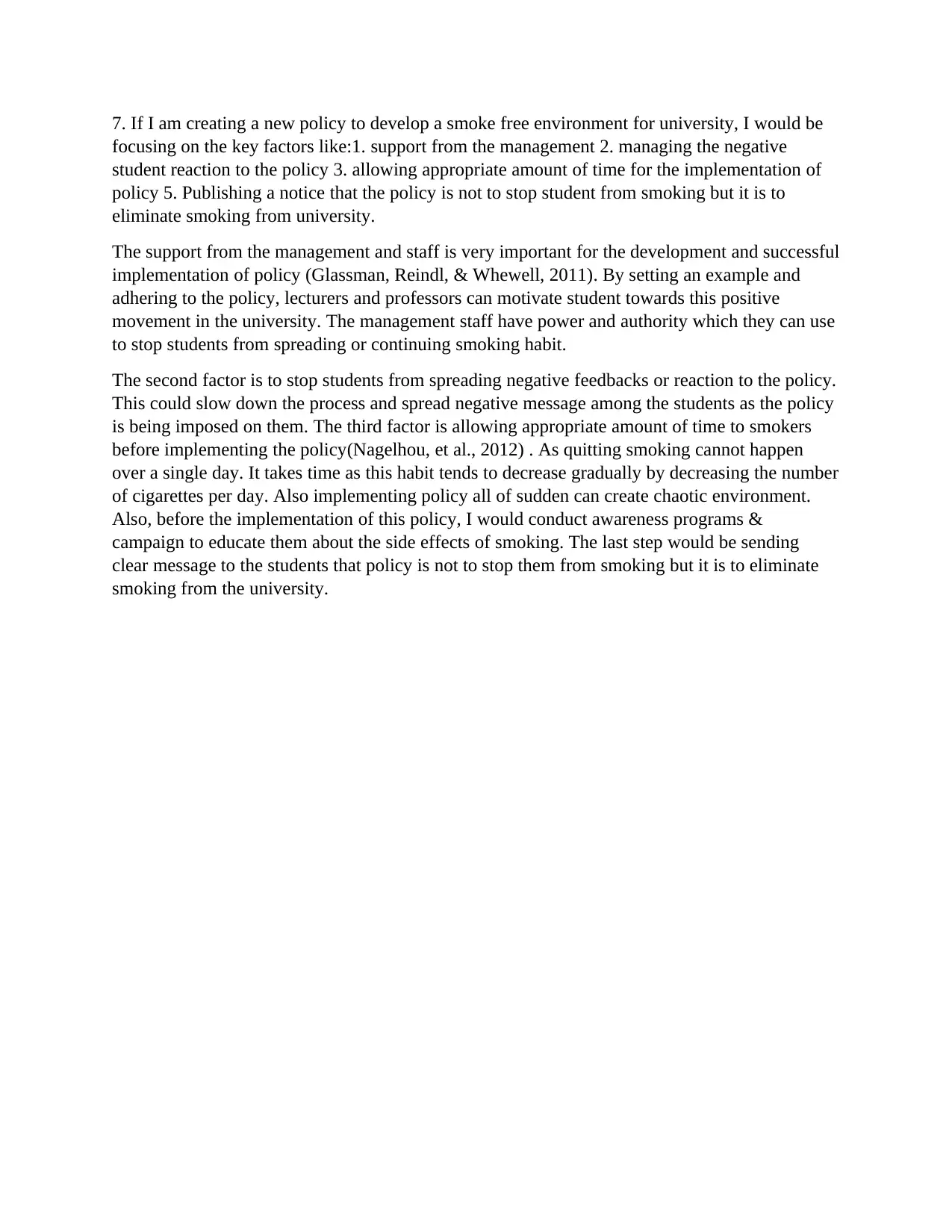
7. If I am creating a new policy to develop a smoke free environment for university, I would be
focusing on the key factors like:1. support from the management 2. managing the negative
student reaction to the policy 3. allowing appropriate amount of time for the implementation of
policy 5. Publishing a notice that the policy is not to stop student from smoking but it is to
eliminate smoking from university.
The support from the management and staff is very important for the development and successful
implementation of policy (Glassman, Reindl, & Whewell, 2011). By setting an example and
adhering to the policy, lecturers and professors can motivate student towards this positive
movement in the university. The management staff have power and authority which they can use
to stop students from spreading or continuing smoking habit.
The second factor is to stop students from spreading negative feedbacks or reaction to the policy.
This could slow down the process and spread negative message among the students as the policy
is being imposed on them. The third factor is allowing appropriate amount of time to smokers
before implementing the policy(Nagelhou, et al., 2012) . As quitting smoking cannot happen
over a single day. It takes time as this habit tends to decrease gradually by decreasing the number
of cigarettes per day. Also implementing policy all of sudden can create chaotic environment.
Also, before the implementation of this policy, I would conduct awareness programs &
campaign to educate them about the side effects of smoking. The last step would be sending
clear message to the students that policy is not to stop them from smoking but it is to eliminate
smoking from the university.
focusing on the key factors like:1. support from the management 2. managing the negative
student reaction to the policy 3. allowing appropriate amount of time for the implementation of
policy 5. Publishing a notice that the policy is not to stop student from smoking but it is to
eliminate smoking from university.
The support from the management and staff is very important for the development and successful
implementation of policy (Glassman, Reindl, & Whewell, 2011). By setting an example and
adhering to the policy, lecturers and professors can motivate student towards this positive
movement in the university. The management staff have power and authority which they can use
to stop students from spreading or continuing smoking habit.
The second factor is to stop students from spreading negative feedbacks or reaction to the policy.
This could slow down the process and spread negative message among the students as the policy
is being imposed on them. The third factor is allowing appropriate amount of time to smokers
before implementing the policy(Nagelhou, et al., 2012) . As quitting smoking cannot happen
over a single day. It takes time as this habit tends to decrease gradually by decreasing the number
of cigarettes per day. Also implementing policy all of sudden can create chaotic environment.
Also, before the implementation of this policy, I would conduct awareness programs &
campaign to educate them about the side effects of smoking. The last step would be sending
clear message to the students that policy is not to stop them from smoking but it is to eliminate
smoking from the university.
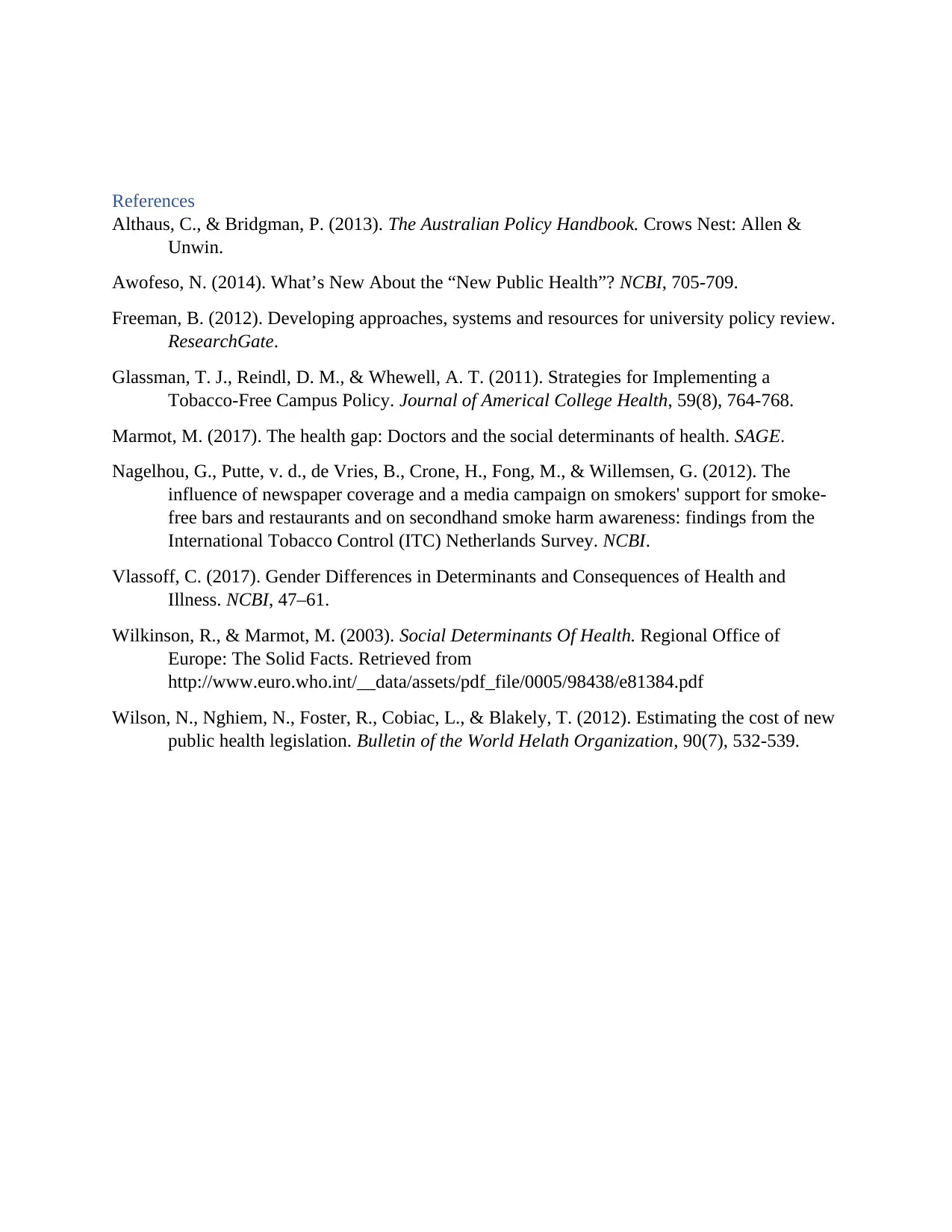
References
Althaus, C., & Bridgman, P. (2013). The Australian Policy Handbook. Crows Nest: Allen &
Unwin.
Awofeso, N. (2014). What’s New About the “New Public Health”? NCBI, 705-709.
Freeman, B. (2012). Developing approaches, systems and resources for university policy review.
ResearchGate.
Glassman, T. J., Reindl, D. M., & Whewell, A. T. (2011). Strategies for Implementing a
Tobacco-Free Campus Policy. Journal of Americal College Health, 59(8), 764-768.
Marmot, M. (2017). The health gap: Doctors and the social determinants of health. SAGE.
Nagelhou, G., Putte, v. d., de Vries, B., Crone, H., Fong, M., & Willemsen, G. (2012). The
influence of newspaper coverage and a media campaign on smokers' support for smoke-
free bars and restaurants and on secondhand smoke harm awareness: findings from the
International Tobacco Control (ITC) Netherlands Survey. NCBI.
Vlassoff, C. (2017). Gender Differences in Determinants and Consequences of Health and
Illness. NCBI, 47–61.
Wilkinson, R., & Marmot, M. (2003). Social Determinants Of Health. Regional Office of
Europe: The Solid Facts. Retrieved from
http://www.euro.who.int/__data/assets/pdf_file/0005/98438/e81384.pdf
Wilson, N., Nghiem, N., Foster, R., Cobiac, L., & Blakely, T. (2012). Estimating the cost of new
public health legislation. Bulletin of the World Helath Organization, 90(7), 532-539.
Althaus, C., & Bridgman, P. (2013). The Australian Policy Handbook. Crows Nest: Allen &
Unwin.
Awofeso, N. (2014). What’s New About the “New Public Health”? NCBI, 705-709.
Freeman, B. (2012). Developing approaches, systems and resources for university policy review.
ResearchGate.
Glassman, T. J., Reindl, D. M., & Whewell, A. T. (2011). Strategies for Implementing a
Tobacco-Free Campus Policy. Journal of Americal College Health, 59(8), 764-768.
Marmot, M. (2017). The health gap: Doctors and the social determinants of health. SAGE.
Nagelhou, G., Putte, v. d., de Vries, B., Crone, H., Fong, M., & Willemsen, G. (2012). The
influence of newspaper coverage and a media campaign on smokers' support for smoke-
free bars and restaurants and on secondhand smoke harm awareness: findings from the
International Tobacco Control (ITC) Netherlands Survey. NCBI.
Vlassoff, C. (2017). Gender Differences in Determinants and Consequences of Health and
Illness. NCBI, 47–61.
Wilkinson, R., & Marmot, M. (2003). Social Determinants Of Health. Regional Office of
Europe: The Solid Facts. Retrieved from
http://www.euro.who.int/__data/assets/pdf_file/0005/98438/e81384.pdf
Wilson, N., Nghiem, N., Foster, R., Cobiac, L., & Blakely, T. (2012). Estimating the cost of new
public health legislation. Bulletin of the World Helath Organization, 90(7), 532-539.
⊘ This is a preview!⊘
Do you want full access?
Subscribe today to unlock all pages.

Trusted by 1+ million students worldwide
1 out of 6
Related Documents
Your All-in-One AI-Powered Toolkit for Academic Success.
+13062052269
info@desklib.com
Available 24*7 on WhatsApp / Email
![[object Object]](/_next/static/media/star-bottom.7253800d.svg)
Unlock your academic potential
Copyright © 2020–2025 A2Z Services. All Rights Reserved. Developed and managed by ZUCOL.




